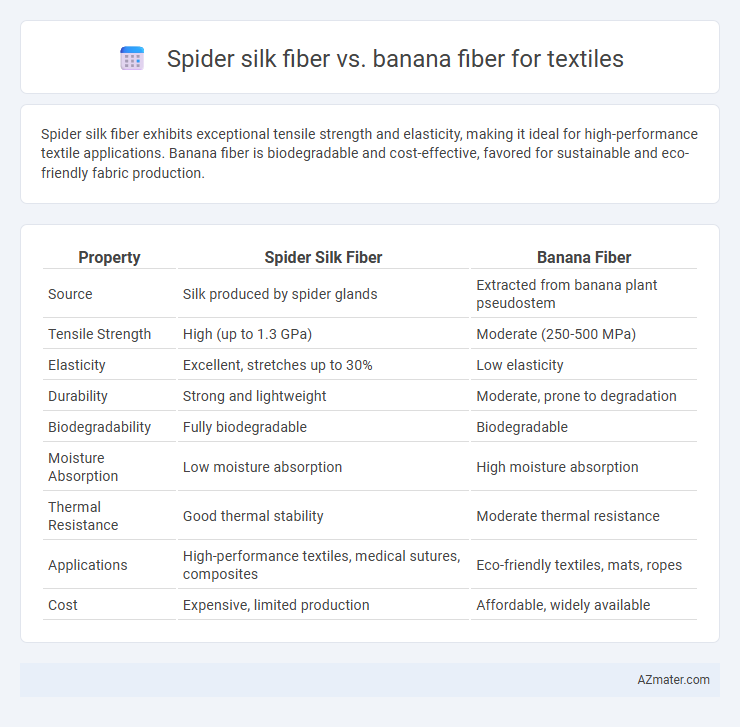Spider silk fiber exhibits exceptional tensile strength and elasticity, making it ideal for high-performance textile applications. Banana fiber is biodegradable and cost-effective, favored for sustainable and eco-friendly fabric production.
Table of Comparison
| Property | Spider Silk Fiber | Banana Fiber |
|---|---|---|
| Source | Silk produced by spider glands | Extracted from banana plant pseudostem |
| Tensile Strength | High (up to 1.3 GPa) | Moderate (250-500 MPa) |
| Elasticity | Excellent, stretches up to 30% | Low elasticity |
| Durability | Strong and lightweight | Moderate, prone to degradation |
| Biodegradability | Fully biodegradable | Biodegradable |
| Moisture Absorption | Low moisture absorption | High moisture absorption |
| Thermal Resistance | Good thermal stability | Moderate thermal resistance |
| Applications | High-performance textiles, medical sutures, composites | Eco-friendly textiles, mats, ropes |
| Cost | Expensive, limited production | Affordable, widely available |
Introduction to Spider Silk and Banana Fiber
Spider silk fiber, renowned for its exceptional tensile strength and elasticity, offers lightweight and biodegradable properties ideal for advanced textile applications. Banana fiber, extracted from the pseudostem of banana plants, provides durable, eco-friendly, and natural cellulose-rich material used in sustainable fabric production. Both fibers contribute to innovative textile solutions by combining strength, flexibility, and environmental benefits.
Origin and Extraction Processes
Spider silk fiber originates from the silk glands of spiders, primarily harvested through a labor-intensive process of manually extracting silk threads from spider spinnerets. Banana fiber is derived from the pseudostem of banana plants, extracted by retting and mechanical decortication to separate fibers from the plant tissue. Both fibers possess unique extraction challenges: spider silk requires delicate handling to avoid harming spiders, while banana fiber extraction involves eco-friendly methods to ensure fiber quality and durability.
Chemical Composition and Structure
Spider silk fiber contains fibroin proteins rich in glycine and alanine, forming highly organized beta-sheet nanocrystals that provide exceptional tensile strength and elasticity; its hierarchical structure includes aligned beta-sheets interspersed with amorphous regions, contributing to its unique mechanical properties. Banana fiber primarily consists of cellulose (approximately 60-70%), hemicellulose, and lignin, with cellulose forming crystalline microfibrils embedded in an amorphous matrix, resulting in moderate strength and stiffness suitable for coarse textiles and composites. The chemical composition and microstructure differences underpin the superior flexibility and toughness of spider silk compared to the rigid and biodegradable qualities of banana fiber in textile applications.
Physical Properties and Strength
Spider silk fiber exhibits exceptional tensile strength and elasticity, surpassing many synthetic and natural fibers, making it highly desirable for durable and flexible textile applications. Banana fiber, derived from banana plant stems, offers good tensile strength and biodegradability but is generally coarser and less elastic compared to spider silk. The superior strength-to-weight ratio and remarkable toughness of spider silk provide distinct advantages in high-performance textiles over banana fiber.
Biodegradability and Environmental Impact
Spider silk fiber exhibits superior biodegradability compared to banana fiber, breaking down naturally without releasing harmful residues. Its production involves minimal environmental impact due to the low energy and chemical inputs required, contrasting with banana fiber's processing, which often demands significant water and chemical use. The sustainable cultivation and harvesting of banana fiber contribute positively, but spider silk's overall ecological footprint remains smaller, positioning it as a more eco-friendly textile alternative.
Textile Performance and Applications
Spider silk fiber exhibits exceptional tensile strength, elasticity, and biocompatibility, making it ideal for high-performance textiles requiring durability and flexibility, such as medical sutures and advanced sportswear. Banana fiber, known for its coarse texture and moderate strength, is primarily used in eco-friendly textile applications, including home furnishings, biodegradable composites, and artisanal fabrics. While spider silk outperforms banana fiber in mechanical properties and fine fabric production, banana fiber offers sustainable advantages suitable for niche textile markets focused on environmental impact.
Dyeability and Finishing Techniques
Spider silk fiber exhibits superior dyeability compared to banana fiber due to its protein-based structure, allowing vibrant and uniform color absorption with reactive and acid dyes. Banana fiber, primarily composed of cellulose, requires pre-treatment such as scouring and bleaching to enhance dye uptake, often responding better to direct and vat dyes. Finishing techniques for spider silk focus on preserving its natural luster and strength through gentle washes and enzyme treatments, whereas banana fiber benefits from softening agents and mechanical processing to improve flexibility and texture for textile applications.
Cost and Scalability of Production
Spider silk fiber offers exceptional strength and elasticity but remains prohibitively expensive and challenging to scale due to complex farming and harvesting processes. Banana fiber, derived from agricultural waste, presents a cost-effective and scalable alternative with growing industrial adoption driven by sustainable production methods. The scalability of banana fiber production benefits from abundant raw materials and simpler extraction, making it more economically viable for large-scale textile manufacturing compared to spider silk.
Sustainability and Eco-Friendly Potential
Spider silk fiber offers exceptional strength, biodegradability, and minimal environmental impact due to its natural protein-based composition, making it a highly sustainable textile option. Banana fiber, derived from agricultural waste, is renewable, biodegradable, and requires less water and chemicals in processing compared to conventional fibers, enhancing its eco-friendly potential. Both fibers contribute to sustainable textiles by reducing reliance on synthetic materials and promoting circular economy practices in the fashion industry.
Future Prospects in Textile Innovation
Spider silk fiber exhibits exceptional tensile strength, biodegradability, and elasticity, positioning it as a revolutionary material for high-performance and sustainable textiles. Banana fiber, derived from agricultural waste, offers strong eco-friendly potential with natural antibacterial properties and a lower environmental footprint. Future prospects in textile innovation emphasize integrating spider silk's advanced biomechanical qualities with banana fiber's sustainability to develop hybrid fabrics that meet rising demands for durability, comfort, and environmental responsibility.

Infographic: Spider silk fiber vs Banana fiber for Textile
 azmater.com
azmater.com